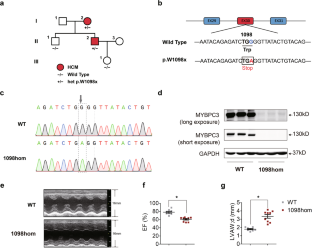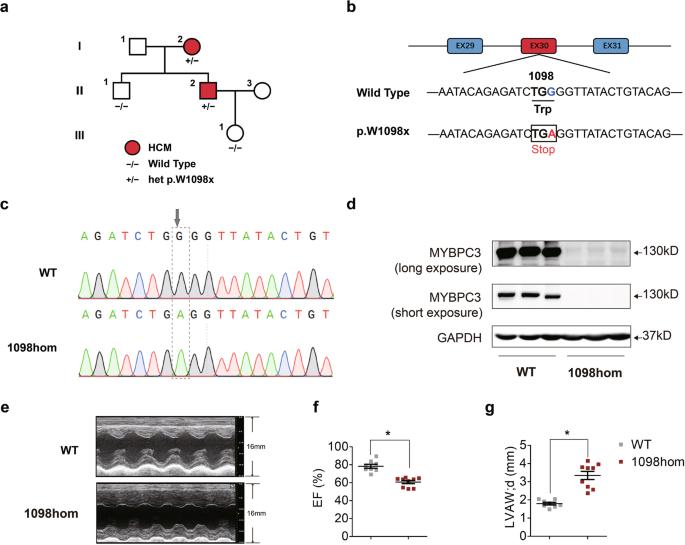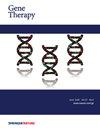肥厚型心肌病大鼠模型中 MYBPC3 基因突变的同源定向修复
IF 4.6
3区 医学
Q1 BIOCHEMISTRY & MOLECULAR BIOLOGY
引用次数: 2
摘要
肌球蛋白结合蛋白 C3(MYBPC3)基因变异是肥厚型心肌病(HCM)的主要病因,占 HCM 变异总数的 30% 至 40%。基因编辑有望永久治愈 HCM。本研究的目的是探讨使用 CRISPR/Cas9 系统在体内对 MYBPC3 进行基因组编辑能否挽救 HCM 大鼠的表型。我们建立了一个 HCM 大鼠模型("1098hom"),该模型携带在人类 HCM 血统中发现的 Mybpc3 提前终止密码子突变(p.W1098x)。在大鼠出生后第 3 天,通过单剂量 AAV9 粒子将 CRISPR/Cas9 系统导入幼鼠体内,利用同源定向修复 (HDR) 纠正该变异。注射 AAV9 6 个月后进行分析。1098hom 大鼠不表达 MYBPC3 蛋白,并出现 HCM 表型,心室壁厚度增加,心脏功能减退。重要的是,CRISPR HDR 基因组编辑纠正了 3.56% 的总突变,恢复了 2.12% 的 MYBPC3 蛋白表达,并使 1098hom 大鼠的 HCM 表型正常化。我们的工作表明,HDR 策略是治疗与 MYBPC3 基因突变相关的 HCM 的一种有前途的方法,CRISPR 技术在治疗遗传性心脏病方面具有巨大潜力。本文章由计算机程序翻译,如有差异,请以英文原文为准。


Homology-directed repair of an MYBPC3 gene mutation in a rat model of hypertrophic cardiomyopathy
Variants in myosin-binding protein C3 (MYBPC3) gene are a main cause of hypertrophic cardiomyopathy (HCM), accounting for 30% to 40% of the total number of HCM mutations. Gene editing represents a potential permanent cure for HCM. The aim of this study was to investigate whether genome editing of MYBPC3 using the CRISPR/Cas9 system in vivo could rescue the phenotype of rats with HCM. We generated a rat model of HCM (“1098hom”) that carried an Mybpc3 premature termination codon mutation (p.W1098x) discovered in a human HCM pedigree. On postnatal day 3, the CRISPR/Cas9 system was introduced into rat pups by a single dose of AAV9 particles to correct the variant using homology-directed repair (HDR). Analysis was performed 6 months after AAV9 injection. The 1098hom rats didn’t express MYBPC3 protein and developed an HCM phenotype with increased ventricular wall thickness and diminished cardiac function. Importantly, CRISPR HDR genome editing corrected 3.56% of total mutations, restored MYBPC3 protein expression by 2.12%, and normalized the HCM phenotype of 1098hom rats. Our work demonstrates that the HDR strategy is a promising approach for treating HCM associated with MYBPC3 mutation, and that CRISPR technology has great potential for treating hereditary heart diseases.
求助全文
通过发布文献求助,成功后即可免费获取论文全文。
去求助
来源期刊

Gene Therapy
医学-生化与分子生物学
CiteScore
9.70
自引率
2.00%
发文量
67
审稿时长
4-8 weeks
期刊介绍:
Gene Therapy covers both the research and clinical applications of novel therapeutic techniques based on a genetic component. Over the last few decades, significant advances in technologies ranging from identifying novel genetic targets that cause disease through to clinical studies, which show therapeutic benefit, have elevated this multidisciplinary field to the forefront of modern medicine.
 求助内容:
求助内容: 应助结果提醒方式:
应助结果提醒方式:


